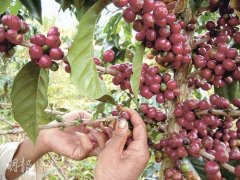Processing of coffee beans after harvest
Coffee beans must be processed immediately after harvest to avoid spoilage. Producers use two treatments: solarization and cleaning. An effective sun-drying method is to spread the berries evenly in the yard and stir the dehydrated berries occasionally to heat and aerate them evenly. The dried berries are then put into a machine that crushes the outer shell and simultaneously removes the outer shell and the parchment film that surrounds it, separating the beans from the inside, sorting and bagging. Alternatively, the berries are mechanically pulped, washed, and finally dried and separated from the parchment outer membrane. Either way, the goal is one: to reduce the water content of coffee berries from 65% to only 10 - 12% green coffee beans.
One of the biggest challenges in making good coffee is making sure to start with good green beans. Top manufacturers, such as illy coffee in trieste, italy, use sophisticated birth-management techniques to reduce the proportion of defective beans. These include UV fluorescence analysis to identify moldy beans and a three-colour map (yellow, green, red and infrared) to create a colour fingerprint for each batch of beans. Illy teamed up with Sotex to develop a two-color sorter system that provides final quality control before green coffee beans are roasted. The method is to pick out the bad beans from the beans falling on the plate by photoelectric detector, and then use a blow from the air nozzle to eliminate them individually. The sorting works at speeds of up to 400 beans per second, which is unmatched by any human, and with an accuracy that even the most trained human eye can't match.
A perfectly ripe green coffee bean consists of unusually thick cells, which can be 5 to 7 microns thick and are rare in the plant world. During the roasting process, these cells, 30 to 40 microns in diameter, act like microreactors, where all the important chemical reactions driven by heat take place; the fascinating taste and aroma of coffee are also produced. Immature coffee beans have thin cell walls and lack important aroma protein precursors produced in the final stages of maturation. After fermentation by bacteria or mold, the beans and cells are emptied of these important substances.
Important Notice :
前街咖啡 FrontStreet Coffee has moved to new addredd:
FrontStreet Coffee Address: 315,Donghua East Road,GuangZhou
Tel:020 38364473
- Prev

Artificial hybrid coffee varieties
Kaduai is an artificial hybrid of Kaddura and Mondu Novo. Kaduai has a good ability to resist natural disasters, especially wind and rain. Kaduai tree species are relatively low, compared with other coffee trees, the fruit of Kaduai is stronger and harder to pick. The fruit is both red and yellow. So far, it has not been found that yellow fruit is better than red fruit.
- Next

Record of coffee bean picking process in Laos
Bolaven Cafe serves clear Americano with breakfast. Arabica beans are picked by hand and twisted one by one with feminine force. Pick only bright red ripe fruit, not green (immature) and dark brown (rotten) fruit. The transparent pulp tastes sweet, and the coffee beans are wrapped in a hard shell in the middle. Farmers carefully and quickly wash freshly peeled coffee beans in preparation for fermentation.
Related
- Guji coffee producing area of Guji, Ethiopia: Humbela, Shakiso, Wulaga
- What is the most expensive variety of Qiloso in BOP multi-variety group?
- How to store the coffee beans bought home?
- Why are Yemeni coffee beans so rare now?
- Ethiopian Sidamo all Red Fruit Sun Sun Santa Vini Coffee beans
- SOE is mostly sour? What does it mean? Is it a single bean? what's the difference between it and Italian blending?
- Is Italian coffee beans suitable for making hand-brewed coffee?
- How to choose coffee beans when making cold coffee? What kind of coffee beans are suitable for making cold coffee?
- Just entered the pit to make coffee, what kind of coffee beans should be chosen?
- Can only Japan buy real Blue Mountain Coffee? What are authentic Jamaican Blue Mountain coffee beans?

